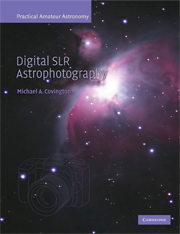12 - Overview of image processing
Published online by Cambridge University Press: 21 August 2009
Summary
This chapter will tell you how to start with raw image files from your camera, perform dark-frame correction, decode the color matrix, combine multiple images into one, and carry out final adjustments.
Vita brevis, ars longa. Digital image processing is a big subject, and I don't plan to cover all of it here. In particular, in this and the following chapters I'm going to skip almost all of the mathematics. To learn how the computations are actually done, see Astrophotography for the Amateur (1999), Chapter 12, and other reference books listed on p. 195.
This is also not a software manual. For concreteness, I'm going to give some specific procedures for using MaxDSLR (including its big brother MaxIm DL) and, in the next chapter, Adobe Photoshop, but in general, it's up the makers of software to tell you how to use it. My job is to help you understand what you're trying to accomplish. Many different software packages will do the same job equally well, and new software is coming out every day.
How to avoid all this work
Before proceeding I should tell you that you don't have to do all this work. A much simpler procedure is to let the camera do most of it for you. Here's how:
Turn on long-exposure noise reduction in your camera. That way, whenever you take a celestial photograph, the camera will automatically take a dark frame and subtract it.
Tell the camera to save the images as JPEG (not raw).
[…]
Information
- Type
- Chapter
- Information
- Digital SLR Astrophotography , pp. 145 - 164Publisher: Cambridge University PressPrint publication year: 2007
